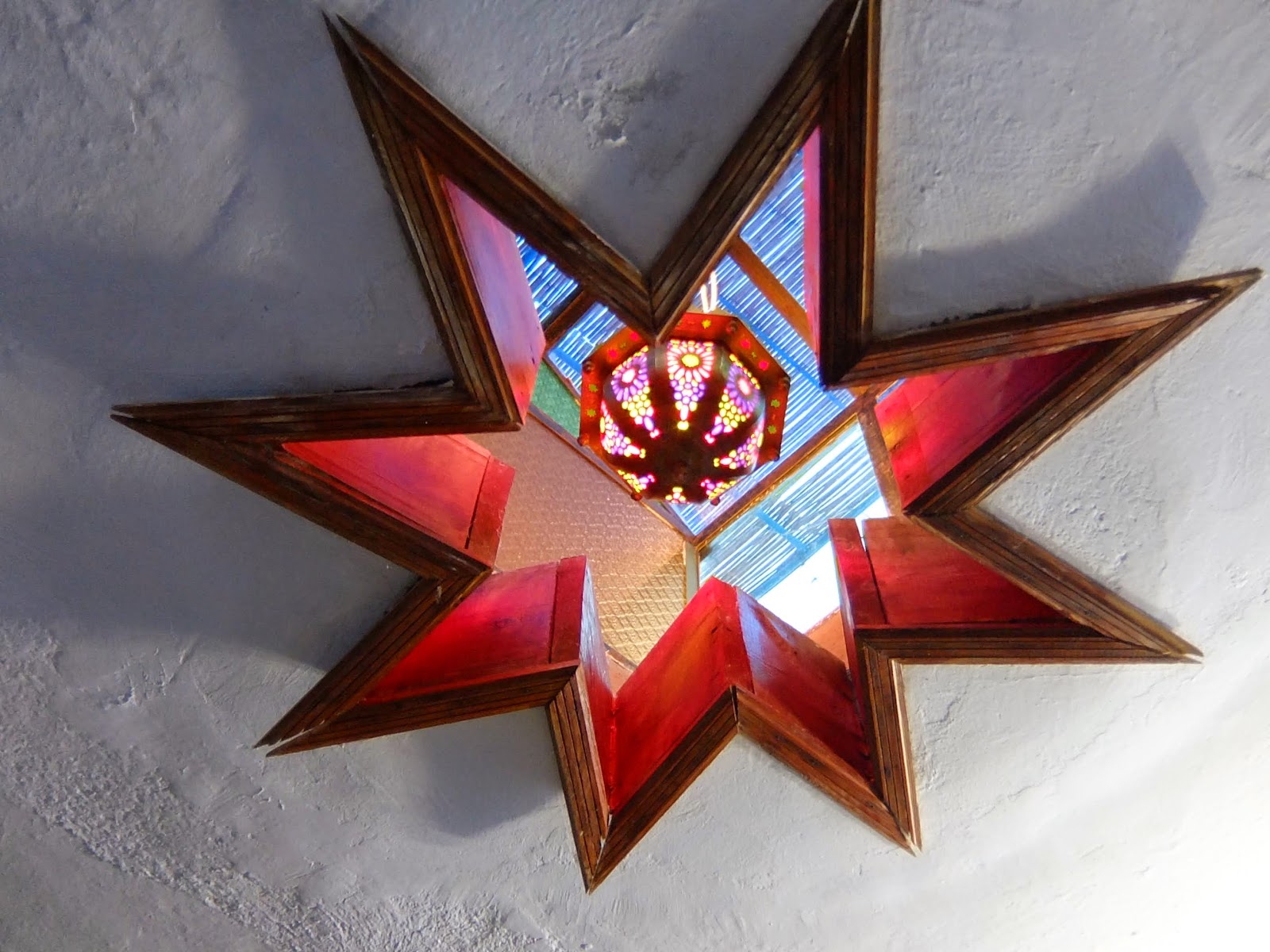The bus took a windy road through the Riff Mountains
 |
| Place Outa El Hamam at night |
From where the bus let us out, we found a taxi and took it to the main square in the medina, Place Outa El Hamam, a fairly romantic square with one side taken by a steep walled fortress and the other sides by outdoor cafes, chairs and umbrellas spilling over the cobbled plaza. From there we had to make our way through the initial blue bends and turns - everything blue, as though there were an effects switch to tint everything blue in your eyes - and finally up to the Casa Elias. With even that just short walk, we were already excited to see the city
 |
| Our window at Casa Elias |
The Casa Elias was a nice place, run by quite an active young Moroccan man who speaks excellent English and has quite the entrepreneurial spirit. The housekeeper, who greeted us, didn't speak a lick of English but could speak French and Spanish and was more than happy to try to communicate with us, especially with the phrase, "Chambre o suite?" repeated over and over. Not really knowing the difference, I just kept saying, "Oui, en le internet, je suis Saint Facetious," until she at least just showed us what was either a chambre or a suite and then we agreed on it. The place, though on the fourth floor, looked and felt like a beautifully decorated cave, with even the bed carved of stone or hardened clay or mud that blended into the floor and ceiling. The single window was in the rooftop, shaped like a star, and there was stained glass above that, filtering in colored light to the room below. The bathroom was a bit dank and smelling like a cave, but what could you expect from such a construction? Something told me that everywhere throughout all the hotels was the same. The rooftop, where they serve breakfast, has a really immense view, looking down across the medina. For that rooftop alone - and really, the room was really neat - I would stay there again.
 |
| A view from the Casa Elias patio |
Chefchouen itself, as I mentioned before, is a blue city. This is by no means an exaggeration. All the tourist manuals are true. The entire medina is painted in various shades of blue - a few buildings got lazy and are stucco white, and there is an occasional red bricked building - usually a landmark, like a castle or a mosque, but one can't be too critical. Most of the streets are wide enough only for one or two people, and one gets the feeling you're in a real fortified city from the medieval days. Apparently, one hundred years ago, it was a green city, and Christians weren't allowed to enter on pain of death. But then the Spanish took the town, forced them to allow Christian tourists, and then the Moroccans - the quick learners that they were - realized that they would be better off taking filthy European and American money from tourists than beheading them. After the Spanish freed up the town, the residents decided green wasn't such a nice color and unanimously decided on blue. I’m not sure what sort of bureaucratic HOA had to head itself over that change of decor, but however the process went, it was quite successful.
 |
| A street in the medina |
We spent the rest of the day exploring the azure labyrinth, going from cafe to cafe, drinking up the hot sweet mint tea and tasteless coffee that are both ubiquitous in Morocco - my advice, stick with the tea. At one place, I enquired about smoking some nargile - a tobacco water pipe.
"No, no, you can't do that hear," he said in a loud whisper. "The police are on about that."
"No, I don't mean hashish, I mean shisha. You know, tobacco."
"Yeah, they've really been on about it. You want to buy some hashish though? I can do that. Maybe come back later tonight and I'll have some for you."
 |
| Another street view |
Strangely, marijuana seemed to be ludicrously easy to get in Chefchouen, with every waiter and guy walking down the street offering to sell some, though just a common water pipe was impossible to find. I understood that my quest to find a relaxing cafe to chill at and smoke water pipe was over. Later, in Fez , I read an article about how the police had been cracking down on cafes and bars that served shisha, as shisha smoking apparently caused women to become loose and to lose their morals. I facepalmed myself on that one, not realizing why that logic hadn't been so clear before.
In all, we only spent that one night in Chefchouen, though I do wish we could have spent maybe one night more there - though the lack of shisha would have made it daunting to find things to do. Good hiking can be found, and rumor had it there was a big waterfall to see, though hikers are also warned about the large plantations of marijuana out in the hills and along trails. Picking the stuff off farms is frowned upon, and you should probably talk to the guy carrying the machine gun about buying some, rather than risking his wrath.
View from a restaurant
|


No comments:
Post a Comment